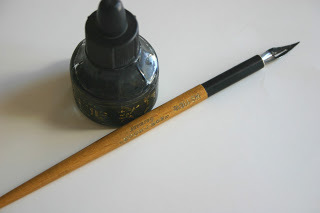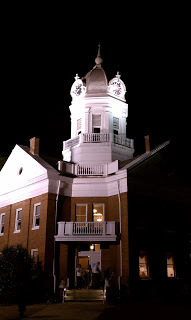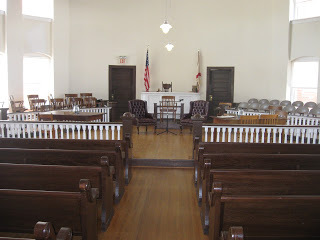Michele Feltman Strider's Blog, page 3
August 31, 2012
Vampires vs Superheroes
According to Pop Culture, the two most important and rewarding career paths open to young people today are “Comic Book Superhero” and “Vampire.”
During this Back-to-School period, when so many of our young people are thinking about their futures and weighing the options open to them, I felt it would be appropriate to compare and contrast the these popular choices.
You're welcome.
Comic Book Superheroes
Vampires
“Do-gooder”
“Blood-sucker”
Wardrobe palette: primary colors
Wardrobe palette: black
Flies around helping people
Flies around eating people
Limited to two dimensions
Limited to nighttime
Motivation: early childhood trauma leading to a life of
vigilantism
Motivation: hunger
Known associates: police, elderly servants and/or relatives,
sexually confused youth
Known associates: other vampires, werewolves,
Main antagonist: brilliant-but-insane super-villain bent on
world domination/destruction
Main antagonist: the sun
Primary Assistant: sidekick
Primary Assistant: minion
Common Habitats: secret lairs, telephone booths, Halls of
Justice
Common Habitats: graveyards, mausoleums, sexy goth night clubs
Affinity for long, dramatic capes: Yes
Affinity for long, dramatic capes: Yes
Ability to wear spandex in public without embarrassment
Year-round leather
Potential sex appeal as a Halloween costume: 7
Potential sex appeal as a Halloween costume: 10
View from the Whedonverse :
The Avengers
View from the Whedonverse :
Buffy the Vampire Slayer
Best Genre Flick Featuring Rutger Hauer : Batman Begins
Best Genre Flick Featuring Rutger Hauer : Buffy the Vampire Slayer
MPAA warning: Violence, Language
MPAA warning: Violence, Language, Nudity, Sexual Situations
Today's lesson: Netflix owns my brain.
Next: Posting will be sketchy for the next week or so, as I'll be in ABQ, NM attempting to eat my weight in green chile. (Any Blake's fans out there?)


During this Back-to-School period, when so many of our young people are thinking about their futures and weighing the options open to them, I felt it would be appropriate to compare and contrast the these popular choices.
You're welcome.
Comic Book Superheroes
Vampires
“Do-gooder”
“Blood-sucker”
Wardrobe palette: primary colors
Wardrobe palette: black
Flies around helping people
Flies around eating people
Limited to two dimensions
Limited to nighttime
Motivation: early childhood trauma leading to a life of
vigilantism
Motivation: hunger
Known associates: police, elderly servants and/or relatives,
sexually confused youth
Known associates: other vampires, werewolves,
Main antagonist: brilliant-but-insane super-villain bent on
world domination/destruction
Main antagonist: the sun
Primary Assistant: sidekick
Primary Assistant: minion
Common Habitats: secret lairs, telephone booths, Halls of
Justice
Common Habitats: graveyards, mausoleums, sexy goth night clubs
Affinity for long, dramatic capes: Yes
Affinity for long, dramatic capes: Yes
Ability to wear spandex in public without embarrassment
Year-round leather
Potential sex appeal as a Halloween costume: 7
Potential sex appeal as a Halloween costume: 10
View from the Whedonverse :
The Avengers
View from the Whedonverse :
Buffy the Vampire Slayer
Best Genre Flick Featuring Rutger Hauer : Batman Begins
Best Genre Flick Featuring Rutger Hauer : Buffy the Vampire Slayer
MPAA warning: Violence, Language
MPAA warning: Violence, Language, Nudity, Sexual Situations
Today's lesson: Netflix owns my brain.
Next: Posting will be sketchy for the next week or so, as I'll be in ABQ, NM attempting to eat my weight in green chile. (Any Blake's fans out there?)

Published on August 31, 2012 07:28
August 29, 2012
Vampire Hunting In Storyville

Once upon a time, when I still did stupid stuff like that, I took a “Vampire Tour” through the New Orleans French Quarter.
In recent years, ghost, vampire, and other such “themed” historical tours have become tourist trap “must haves.” This was a while ago, though, when both the concept and I were much younger.
For this walking tour, I wore – as one naturally would – head-to-toe 1970s disco-wear, complete with platform shoes. I also invited my brother, Fino Chevere, as every responsible elder sibling does when going on a glorified pub crawl.
We met our guide on the corner of Burgundy and Something Else Streets sometime after dark. The only reason I remember that much is because said guide – a confused and charisma-challenged young man – pronounced it “Burr-gundy.” “Oh good,” I remember thinking, “He's a local.”
Storytelling is an art. A gifted storyteller leads you, transfixed and transported, through his story.
Unfortunately, this was not that guy. Our guide managed to make telling sexy and/or gruesome ghost stories at night in the midst of the French Quarter feel like a 4th grade social studies lecture on the chief imports and exports of Brussels.*
And did I mention it was raining?
Fortunately, the real mission of these tours is not to tell vampire stories, but to drive your tourist dollar into bars off the beaten path who have contracted with your tour company to do just that. So, ultimately, it worked out well for all concerned.
In one of these bars, we met the now-departed Ruthie the Duck Girl , but sadly, not her duck. When asked, she informed us that it was “too wet” out... for a duck. Which made our soggy lot feel very clever, indeed...
At one point, the guide led the ever-dwindling group down to the bank of the Mississippi River. I guess we were looking a little the worse for wear at this point. On our shuffling death march toward the water, we passed a couple of locals passing a bottle. We overheard one ask the other “Who are they?” and his friend reply, “I dunno, but if they all jump in, I'm going in after them.” I still think that was awfully goodhearted of the fella.
At some point in the tour, our guide gave up even trying to tell stories – that point being long after we'd all stopped listening – and quietly accepted his new role as babysitter of a bunch of tipsy idiots. He hustled this small, tight-and-I-do-mean-tight knot of hardcore remainders from bar to bar for a while longer, before dumping us unceremoniously in front of St. Louis Cathedral . Or I think he did... It's also possible that Fino and I got bored and wandered off when he started talking about Blue Dog .
What, you may well ask, is the point of the above story?
It happened around 1995, ten years before Hurricane Katrina became New Orleans' primary narrative. Even then, the city had been host to enough scenes of violence, disaster, and tragedy to fill a long, storied night. It also has a long history of storytellers – writers, musicians, and other artists – acting both as witnesses to and curators of these events.
It's true that the New Orleans I knew and loved no longer exists outside of the stories I have to tell, but more or less drastically, that ends up being true of all places from our past. No place and no person is exempt from the progress of time and change will happen both for good and for ill. Chapters end, but the story goes on.
Today's lesson: No lesson. Just a ghost story.
Next: Vampire vs. Superhero
________________________________________________________________
*Not brussel sprouts

Published on August 29, 2012 06:58
August 22, 2012
The Worst Novel Ever Written

by Michele Feltman Strider
After my first book Homecoming: A Novella was published, I wrote a second one.
Nope. Not Hometown . That's actually number three.
My second book is an untitled novel that will never see the light of day.
It was set in Miami and featured an heiress/socialite named Rachel.
And, dear lord, is it awful.
The first problem was the characters. There was:
Madeline, Rachel's mother, a flighty, spoiled widow with a mysterious past...
Alexander, a handsome, older, Eastern European businessman with a mysterious past...
Ian, the charming British advertising wizard with a mysterious past...
And so on and so on and scooby dooby dooby
There were at least six major characters, all with mysterious pasts. I'm telling you, Agatha Christie would have loved these people – but she'd have been the only one.
The settings were all ultra-fabulous: chic Miami art galleries, glamorous clubs in South Beach, a stunning wooden yacht on Biscayne Bay... There was even a whirlwind trip to Paris to go lingerie shopping.
And let's not even get into the sex scenes. Really. Let's just don't.
Halfway through reading it, my most respected and cherished editor said, as lovingly as possible, “I'm not really sure why I'm reading this.”
Which was a valid question. I wasn't really sure why I'd written it... or why it turned out so badly.
Some sections are decent, I think. I've even culled a good monologue or two from it. The book as a whole, though – disastrous.
And that's OK.
Since then I've spent time with it, analyzing why it doesn't work, and that exercise has served me well. So did failing.
Too often we stifle ourselves with the blanket question “What if I screw up?”
Chances are good that you will, the first time... and maybe the second, third, fourth, and eighty-ninth times, too. Everyone does. The popularity of pencil erasers, liquid paper, and the delete key are evidence of that fact.
As for my truly awful second novel, though no one else will ever, ever lay eyes on it, I've decided to keep it on my backup drive, so I can revisit it from time to time. Like a child's height chart on the kitchen wall, looking back on it will show me how much I've grown.
Reward doesn't come without risk and every failure is an opportunity for growth. Backsliding only means you have work to do to catch up and falling down just gives you a chance to try again. The steeper the mountains you climb, the more rewarding the view from the summit.
Today's lesson: I get knocked down, but I get up again. You're never gonna keep me down . (Enjoy the earworm...)
Next: Depends on what I run across on YouTube .

Published on August 22, 2012 07:33
August 15, 2012
A Writer Prepares

When corresponding with my legions of adoring fans,* the question I am most often asked is: “How do you write your books?”
OK, the actual #1 email question I get is: “Will you help a deposed Nigerian prince with a complicated international cash transfer?” But for the sake of this blog post, let's go with the other one.
The most truthful and complete answer is: I dunno.
If that's not long-winded and self-serving enough, allow me to go into more detail.
As many of you know, I dedicated my misspent youth to stage acting. Why? I guess I couldn't think of anything less germane** to our modern society. I seemed to think I was an
In my short academic career, I attended a reasonable number of English Literature classes and feel that they, undoubtedly, made me a more sophisticated reader. They introduced me to the depth and breadth of literature already in existence and gave me the tools to better appreciate it. By and large, though, these classes taught me little about how to create new literature of my own.

For that, I had to go to the Theatre Department.
In a Literature class, written works are viewed as the final product of the author's artistic process. Each is self-contained and final – a closed system, a completed statement.
In the Theatre – whether you're an actor, director, or designer – literature is the inspiration for the artistic process. Written works are treated as dynamic, open to investigation and interpretation. It was this “living” treatment of literature that taught me how to actually tell my own stories. Below is just some of what I learned:
Conflict is not optional. Neither is research.
The piece should have an overarching theme/concept. (which might or might not be apparent to the author before the story is complete.)
Each work inhabits a fictional universe, with it's own inviolate rules which must be established for the audience.
Each character needs an ultimate goal or “through-line” to motivate them through the piece.
In every scene you write, each character needs to have a desired outcome and should use varying tactics to achieve that goal.
The goals and tactics assigned to a character in any given situation must support that character's through-line.
Characters' goals, tactics, and through-lines need to be supported by the text and your research, and cannot violate the rules of the fictional universe.
All of the above must be interesting to your audience.
The process by which I create a character on paper is very similar to how an actor prepares for a role. In writing and populating a novel-length story, I liken my role more to that of a director. Like a director, I also rely on a crew of editors, proof-readers, etc. for valuable technical assistance.
I also depend on my audience, for your suspension of disbelief and – most importantly – your willingness to be witness to the stories I tell. My thanks to you all. I'm not just being glib when I say that I literally couldn't do it without you. (Pun semi-intended)
Today's lesson: There is only one way to know if I've achieved any of the above. Read Homecoming and Hometown . (And write a review, holding me to the above standards, if you're so inspired.)
Next: Something less self-serving. (Yeah... prolly not...)
______________________________________________________________
*Hi Mom.
**Until I decided to write literary fiction, that is. And have I mentioned my stint in public radio? Next career move: Learn VCR repair.
***Suitable for framing or for folding into a harisen for slapping one's self in the head while reading this: The 20 Best- and Worst-Paid College Majors (My thanks to Zonbi_Kira for introducing me to harisen!)

Published on August 15, 2012 07:12
August 10, 2012
Kickin' It On the Six-Six
 As you may know from my obsessive need to “Check in” on
Facebook
, I spent last week on a road trip to, of all places,
Gallup, New Mexico
.
As you may know from my obsessive need to “Check in” on
Facebook
, I spent last week on a road trip to, of all places,
Gallup, New Mexico
.What?!? You've never holidayed in Gallup?
Actually, Gallup is a lovely area. Someone should consider building a town there.
Gallup is located on historic Route 66 . I mean, right alongside it. It's the town's main thoroughfare. If you're looking for a gas station, drive-in/thru burger joint, or “real” Indian jewelry, boy howdy, do I have the place for you.
Americana: I have now officially cruised Route 66 on a Saturday night in a Ford while listening to Bill Haley. I could not have felt more American if I myself had been “made in Detroit.” Oh, wait...
If you should ever find yourself in Gallup for longer than it takes to fill up at the gas station, allow me to recommend Virgie's Restaurant. Do not be put off by the adult bookstore next door. This slightly sketchy-looking restaurant serves family friendly New Mexican home-cooking and does not have a functioning website. What's not to love?
An open apology to Camille's Sidewalk Cafe in Gallup: I now realize that the food fight was ill-advised. My apologies and I hope you were able to get all of the salsa off the wall.
 We also took a quick detour over to Albuquerque to visit
Fino Chevere
, owner of the best stocked liquor cabinet in New Mexico. Thanks again for the hospitality, little brother, – or, at least, what I remember of it.
We also took a quick detour over to Albuquerque to visit
Fino Chevere
, owner of the best stocked liquor cabinet in New Mexico. Thanks again for the hospitality, little brother, – or, at least, what I remember of it. To the waitress with the pink-trimmed panties at The Library in Albuquerque: We were amused. Thank you.
Fun Fact: It is possible to drive from Albuquerque, NM to Albany, CA in one day, if you miss your cats enough.
That being said, I do not recommend trying this stunt on a Sunday night, when half of the earth's population is also trying to go north on I-5*... with multiple lane closures... and Pea Soup Andersen's is closed for the night... Boo!
Though there is no reason you ever would be, if you're ever in the Cannery Casino in North Las Vegas,** try the posole. Really.
Today's lesson: With road trips, as in life, it's the journey not the destination that matters.
Next: That bit about my writing process that I threatened last time.
___________________________________________________________
*I-5 = smelliest Interstate in the U.S. The feed lot... oh, dear god, the feed lot...
*≠ Las Vegas

Published on August 10, 2012 07:29
July 27, 2012
It Ain't Easy
It was cold when we left Wyoming in the dark early hours. Without windchill, the temperature was just above freezing. At speed, it was well below. At that temperature, heated accessories keep you functional, not comfortable. Jim hunkered down behind the short sport windscreen to avoid at least some of the wind, and I tucked in behind him as closely as I could. We had over 1000 miles to travel across 4 states... and fewer than 24 hours in which to do it. We were racing the clock to complete an Iron Butt Association Saddle Sore 1000 motorcycle ride, and neither snow nor rain nor heat nor gloom of night* was going to keep us fools from the swift completion of this crazy stunt.
We made it, with a few** hours to spare even. The following day, we were both dehydrated, exhausted, and useless... and ridiculously happy.
According to legend, when asked why he wanted to climb Mount Everest, mountaineer George Mallory replied “Because it's there.”
I propose the following refinement to this oft-quoted justification for doing preposterous things: Because it sucks .

It's fun to participate in activities that you find “easy” and at which you excel. It can also be equally, if differently, rewarding to try your hand at something you find extremely challenging. Even making the attempt is a notable accomplishment. If you succeed, all the better.
Beginning today, July 27, athletes from all over the world will compete in the 2012 Summer Olympic Games. They've been training for years in preparation for these few days. They cannot remember a time when their bodies did not ache, or a day when they did not push themselves to the limit of human endurance. They've taken no holidays, vacations, or days off. They've pursued competition over comfort, excellence over ease. They've battled for this chance to compete at the top and now they face their most daunting opponents – each other.
Some will win gold, others silver or bronze. Some will take home only bags of swag from the sponsors – along with a well-earned sense of pride for having undertaken this Olympic challenge.
Today's lesson: In case you've been hiding under a rock for the past month, the Olympic Games begin today.***
Next: A Writer Prepares – a look into my writing process.
_____________________________________________________
*We rode through all that and then some. Also, my husband has made runs like this several times now. He is, after all, Jim Strider, big bike rider.
**No, I won't tell you the exact finish time, as Highway Patrol officers are proficient in basic math skills and I'm not sure what the statute of limitations is in, say, Utah.
***Debate: Team USA's 60s flight attendant chinoiserie chic vs. Team Spain's Burger King look. Post snarky observations in the comments section below...

We made it, with a few** hours to spare even. The following day, we were both dehydrated, exhausted, and useless... and ridiculously happy.
According to legend, when asked why he wanted to climb Mount Everest, mountaineer George Mallory replied “Because it's there.”
I propose the following refinement to this oft-quoted justification for doing preposterous things: Because it sucks .

It's fun to participate in activities that you find “easy” and at which you excel. It can also be equally, if differently, rewarding to try your hand at something you find extremely challenging. Even making the attempt is a notable accomplishment. If you succeed, all the better.
Beginning today, July 27, athletes from all over the world will compete in the 2012 Summer Olympic Games. They've been training for years in preparation for these few days. They cannot remember a time when their bodies did not ache, or a day when they did not push themselves to the limit of human endurance. They've taken no holidays, vacations, or days off. They've pursued competition over comfort, excellence over ease. They've battled for this chance to compete at the top and now they face their most daunting opponents – each other.
Some will win gold, others silver or bronze. Some will take home only bags of swag from the sponsors – along with a well-earned sense of pride for having undertaken this Olympic challenge.
Today's lesson: In case you've been hiding under a rock for the past month, the Olympic Games begin today.***
Next: A Writer Prepares – a look into my writing process.
_____________________________________________________
*We rode through all that and then some. Also, my husband has made runs like this several times now. He is, after all, Jim Strider, big bike rider.
**No, I won't tell you the exact finish time, as Highway Patrol officers are proficient in basic math skills and I'm not sure what the statute of limitations is in, say, Utah.
***Debate: Team USA's 60s flight attendant chinoiserie chic vs. Team Spain's Burger King look. Post snarky observations in the comments section below...

Published on July 27, 2012 07:29
July 11, 2012
Mockingbirds, Finches, Motorcycles, and a Courthouse
On July 11, 1960, the world was first introduced to Miss Jean Louise Finch of Maycomb County, Alabama.
But you probably know her better as Scout.
Since that day, people all around the world have come to cherish her, Jem, Calpurnia, Miss Maudie, Tom Robinson, May Ella Ewell, the exquisite Atticus, and the other characters who so richly inhabit Harper Lee's masterpiece To Kill A Mockingbird .
Like many people, I rank this book and the 1962 film, with it's Horton Foote screenplay, among my very favorites.
Today, however, I write not of the book, its characters, the importance of its themes, or the enormity of its effect around the world, but of the town that inspired it.

The courthouse exterior
Monroeville, Alabama
Even when I lived in Alabama, there was no reason to go to Monroeville. It wasn't close to the Interstate or near a city of any size. You didn't drive through it on your way to the beach or back from one of the University towns after a football game. In fact, you pretty much had to go out of your way to get there at all, which may be why the outlet mall didn't make it... and paper pulp and lumber industries did.
Monroeville was as much a “tired old town” as its fictional counterpart Maycomb when I first knew it and I'd be lying if I said it was a bustling metropolis today. Like Maycomb, though, what Monroeville does have is a population of extraordinary townsfolk.
The first time I visited the Monroeville County Courthouse, my father and I sort of stumbled across it while out for a meandering motorcycle ride.* I was aware that the town, and specifically the courthouse, had inspired the settings of the book and film. I did not dream, however, that we would be able to walk around inside and explore the old building – which ended up being not only a fantastic museum dedicated to the town's most notable residents, Harper Lee and Truman Capote, but the home to the annual Southern Alabama Writer's Symposium** as well. I was blown away.
Then a smiling docent asked us, “Are y'all here for the play?”
Every year since 1991, an all-volunteer cast of locals has staged a full-length production of To Kill A Mockingbird in and around the iconic courthouse. I had the good fortune of seeing the 2012 production and can see why every performance sells out every year.
We sat in the courthouse square of the town where Harper Lee grew up and still lives today, where she and fellow literary giant Truman Capote once played, and where the real-life experiences that would one day inspire the novel had unfolded. We walked the same grounds, sat beneath the same sky, smelled the same pines, saw the same sunset, heard people speak in same purring drawl, and fanned ourselves against the same stagnant, sticky heat, watching as those same events were reenacted in real time. That experience is possible in only one place in the world -- the town of Monroeville.

I did manage to snag a seat on stage for Act 2. Gotta be me...
Monroeville is still a small, rural Alabama town, just as it was in the 1930s when Harper Lee was a child, in the 1960s when the world knew it as Maycomb, or in the 1990s when I was barely aware of it at all.
It is not blessed with favorable geography, a breadth of salable resources, or an over-abundance of material wealth. It will never be a center of fashion or culture or a capitol of commerce or industry. Yet, it will always be the home of Scout, Jem, Dill, Boo, Atticus, and Miss Nelle Harper E. Lee.
Today's lesson: Great inspiration rather than dense population is what makes a place special.
Next: Given my recent pattern, probably a long stretch of silence. :-(
________________________________________________________
*My dad is cooler than your dad.
**Y'all should call me.

But you probably know her better as Scout.
Since that day, people all around the world have come to cherish her, Jem, Calpurnia, Miss Maudie, Tom Robinson, May Ella Ewell, the exquisite Atticus, and the other characters who so richly inhabit Harper Lee's masterpiece To Kill A Mockingbird .
Like many people, I rank this book and the 1962 film, with it's Horton Foote screenplay, among my very favorites.
Today, however, I write not of the book, its characters, the importance of its themes, or the enormity of its effect around the world, but of the town that inspired it.

The courthouse exterior
Monroeville, Alabama
Even when I lived in Alabama, there was no reason to go to Monroeville. It wasn't close to the Interstate or near a city of any size. You didn't drive through it on your way to the beach or back from one of the University towns after a football game. In fact, you pretty much had to go out of your way to get there at all, which may be why the outlet mall didn't make it... and paper pulp and lumber industries did.
Monroeville was as much a “tired old town” as its fictional counterpart Maycomb when I first knew it and I'd be lying if I said it was a bustling metropolis today. Like Maycomb, though, what Monroeville does have is a population of extraordinary townsfolk.
The first time I visited the Monroeville County Courthouse, my father and I sort of stumbled across it while out for a meandering motorcycle ride.* I was aware that the town, and specifically the courthouse, had inspired the settings of the book and film. I did not dream, however, that we would be able to walk around inside and explore the old building – which ended up being not only a fantastic museum dedicated to the town's most notable residents, Harper Lee and Truman Capote, but the home to the annual Southern Alabama Writer's Symposium** as well. I was blown away.
Then a smiling docent asked us, “Are y'all here for the play?”
Every year since 1991, an all-volunteer cast of locals has staged a full-length production of To Kill A Mockingbird in and around the iconic courthouse. I had the good fortune of seeing the 2012 production and can see why every performance sells out every year.
We sat in the courthouse square of the town where Harper Lee grew up and still lives today, where she and fellow literary giant Truman Capote once played, and where the real-life experiences that would one day inspire the novel had unfolded. We walked the same grounds, sat beneath the same sky, smelled the same pines, saw the same sunset, heard people speak in same purring drawl, and fanned ourselves against the same stagnant, sticky heat, watching as those same events were reenacted in real time. That experience is possible in only one place in the world -- the town of Monroeville.

I did manage to snag a seat on stage for Act 2. Gotta be me...
Monroeville is still a small, rural Alabama town, just as it was in the 1930s when Harper Lee was a child, in the 1960s when the world knew it as Maycomb, or in the 1990s when I was barely aware of it at all.
It is not blessed with favorable geography, a breadth of salable resources, or an over-abundance of material wealth. It will never be a center of fashion or culture or a capitol of commerce or industry. Yet, it will always be the home of Scout, Jem, Dill, Boo, Atticus, and Miss Nelle Harper E. Lee.
Today's lesson: Great inspiration rather than dense population is what makes a place special.
Next: Given my recent pattern, probably a long stretch of silence. :-(
________________________________________________________
*My dad is cooler than your dad.
**Y'all should call me.

Published on July 11, 2012 11:00
July 3, 2012
Stuff I Learned While Trying To Research a Blog Post About Independence Day

I started out intending to write an insightful, thought-provoking post about the July 4th holiday. After doing a bit of internet research, I ended up with this strange mix of semi-information instead.
Flag Stuff!
In 2011, we spent $3.6 million importing U.S. flags. Of that, $3.3 million was spent on flags made in China. (Which is nothing compared to what we spent importing fireworks from China in 2011 – over $232 million!)
Which country imports the largest number of U.S. Flags from us? Mexico.
The stars were added to the flag by Francis Hopkinson of New Jersey, a signer of the Declaration of Independence who also helped to design the Great Seal of the United States. Hopkinson submitted to the Continental Admiralty Board an invoice for "a Quarter Cask of the public Wine” as “a proper & reasonable Reward for these Labours of Fancy and a suitable Encouragement to future Exertions of a like Nature," but was denied.
Comfort Food!
From the National Park Service Website: Bess Truman's Mac & Cheese
From the Senate Website: Bean Soup
 Celebrations
Celebrations
The hot dog* eating contest allegedly began as a way to settle a dispute among a group of immigrants over who was more patriotic – because nothing says “I'm an American” like excessive consumption and heartburn?
George Washington was said to have marked the occasion in 1778 by giving his troops a double ration of rum. There was a reason this man was elected our first president.
Martha Stewart recommends celebrating by making “Festive Window Swag” and “Tissue Fan Fireworks.” I recommend that we all ignore Martha Stewart.
Closures
The post office will not deliver mail on this holiday, so plan ahead, Netflix-wise.
Banks will also be closed for the day, probably for our own good, since we as a Nation seem to have no sense of fiscal self-control when flags and fireworks are involved.
Other
The result of typing the words “Independence Day” into Google could lead one to believe that the 1996 Will Smith movie was a far more seminal event in our nation's history than anything that happened in 1776.
Today's lesson: Tomorrow is July 4.
Next: July 5.
_________________________________________________________________
*In 1870, German immigrant Charles Feltman first introduced the hot dog to the United States. 105 years later, descendant of German immigrants Theresa Feltman (no relation) first introduced the hot dog to my tummy.

Published on July 03, 2012 08:13



















